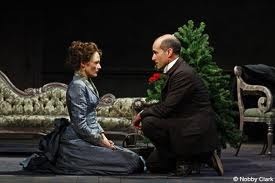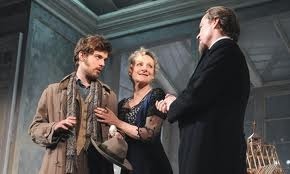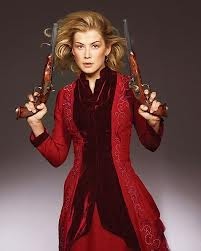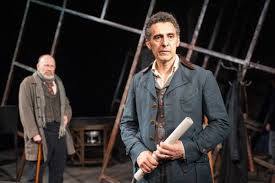Devon Trevarrow Flaherty's Blog, page 76
September 1, 2013
Those Summer Nights
This has been a slow month for lots of things pertaining to this blog, and yet one of the most eventful months of my life. My husband has started his new career as a nurse, my youngest child has scooted off to kindergarten, and I have started working five days a week, 9am-230pm. As a writer. Pretty cool, huh?
August is also my birthday month. So happy birthday to me.
And Owl and Zebra Press got its first real snail mail at its PO Box, which also happened to be the certificate from the Library of Congress, letting us know that Benevolent (including the art and editing) is officially copyrighted and on file at the Library (with a big L).
And I joined a local writing group, finally.
And when I returned from visiting family in New York, I discovered that Benevolent is Indie Reader Approved! Check it out if you want to read the review. It is very nice, I think.
So, besides the fact that I am hard at work writing The Family Elephant’s Jewels (section three), beginning a novella spin-off of Benevolent, and spear-heading a project hopeful for Owl and Zebra Press, I have had moments of scrap time (hah!) to watch something besides “Hamlet” versions (see Book Review of Hamlet to hear all about those). And here they are:
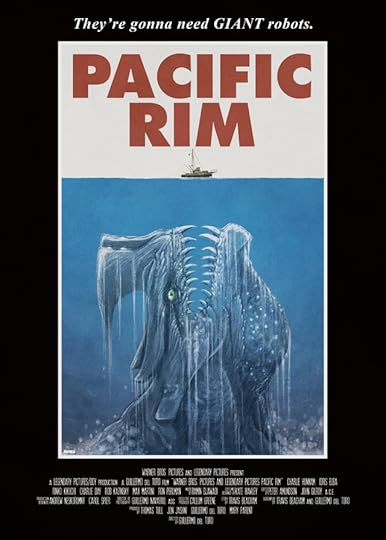 Pacific Rim (2013), which I got to see at the theater on our annual Syracuse date, after a great meal at Kitty Hoynes in Armory Circle. I really like Cloverfield, so we though I might like this new, modern kaiju movie. I did, but with limitations. It wasn’t something I would watch over again or recommend too strongly, but it was good, clean fun nonetheless. Entertaining. Maybe a little scary. Predictable. And interesting, too. Spurs conversation, not about the movie itself so much, but about mind melds and Japanese film.
Pacific Rim (2013), which I got to see at the theater on our annual Syracuse date, after a great meal at Kitty Hoynes in Armory Circle. I really like Cloverfield, so we though I might like this new, modern kaiju movie. I did, but with limitations. It wasn’t something I would watch over again or recommend too strongly, but it was good, clean fun nonetheless. Entertaining. Maybe a little scary. Predictable. And interesting, too. Spurs conversation, not about the movie itself so much, but about mind melds and Japanese film.
N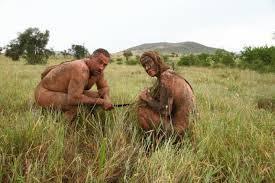 aked and Afraid (series, 2013-). When I first heard about this show, I made fun of it. I mean, what is the state of our culture when we actually have a reality show where they drop two strangers, naked, into a harsh environment, and film them for 21 days, hoping they survive and do something interesting? Well, I’ve only seen a few episodes, but strangely enough, I sort of enjoyed it. I don’t know how long I could watch the show, but a few episodes are enough to get you spinning psychological and anthropological hypotheses like a professional. So, more interesting conversation.
aked and Afraid (series, 2013-). When I first heard about this show, I made fun of it. I mean, what is the state of our culture when we actually have a reality show where they drop two strangers, naked, into a harsh environment, and film them for 21 days, hoping they survive and do something interesting? Well, I’ve only seen a few episodes, but strangely enough, I sort of enjoyed it. I don’t know how long I could watch the show, but a few episodes are enough to get you spinning psychological and anthropological hypotheses like a professional. So, more interesting conversation.
She rlock (British series, 2010-). I am not the only one who loves this series. It’s not all airtight or anything, but it is addictive. Originally, I understood that the smart and fun series based on Sir Arthur Conan Doyle’s books was complete at two seasons of three 1-and-1/2 hours episodes each. However, they left season two with a cliffhanger, and have announced that another three-episode season is on the way… some day. Until then, if you haven’t already seen them, you’ll want to get them on your Netflix or Hulu or Amazon Prime or whatever. Yes, you will.
rlock (British series, 2010-). I am not the only one who loves this series. It’s not all airtight or anything, but it is addictive. Originally, I understood that the smart and fun series based on Sir Arthur Conan Doyle’s books was complete at two seasons of three 1-and-1/2 hours episodes each. However, they left season two with a cliffhanger, and have announced that another three-episode season is on the way… some day. Until then, if you haven’t already seen them, you’ll want to get them on your Netflix or Hulu or Amazon Prime or whatever. Yes, you will.
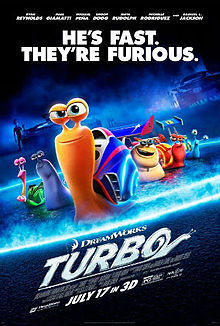 Turbo (2013). Rounding out the month very nicely, I spend a mommy-son date at the end with Eamon, a bag of popcorn, and tickets to Turbo. Admittedly, it starts slow, but it eventually delivers, making it one of the better kid movies of the year. But be forewarned: themes of prospering through bucking authority are prevalent, as well as themes of being able to accomplish anything–even the physically impossible–if one just applies oneself… or wishes on an airplane. I personally believe these are two of the most tired and dangerous themes in children’s entertainment, but it is everywhere.
Turbo (2013). Rounding out the month very nicely, I spend a mommy-son date at the end with Eamon, a bag of popcorn, and tickets to Turbo. Admittedly, it starts slow, but it eventually delivers, making it one of the better kid movies of the year. But be forewarned: themes of prospering through bucking authority are prevalent, as well as themes of being able to accomplish anything–even the physically impossible–if one just applies oneself… or wishes on an airplane. I personally believe these are two of the most tired and dangerous themes in children’s entertainment, but it is everywhere.


August 28, 2013
What Writing Means
I have been reading an article in Poets & Writers about current writers (and book sellers) in Egypt. (Yes, I am a couple months behind on my trade reading.) With the continuing upheaval (think Arab Spring and then lots more) in the country, it is precarious to be a writer or to be selling modern fiction because of censorship, political unrest, and increasing extremist Moslem influence on the politics and law. To be honest, I wondered at first what this article–mostly informative and diary–was doing leading the magazine. But the further I get from it, the more I think about the images it created in my mind’s eye.
As writers (and publishers and book sellers and readers and story-keepers), we have a tradition of overcoming (this is a prevalent word in my own life, lately). And of what? I wanted to explore some action verbs, here. Writers overcome by… Teaching. Enlightening. Pushing boundaries. Leading. Challenging. Entertaining. Surprising. Shocking. Questioning. Scaring. Amusing.
I know there are some purists out there who claim writers write because the are compelled or because they like to. Some say writing is just writing. And still others (myself not excluded) say that writers write for money. Well, many of them do. That’s true. Writers are sometimes compelled, they usually enjoy it, and they try to make money doing it (in general). I am also willing to concede that writing is writing. It is.
But I’m not willing to admit that writing is just writing or that its possibilities end with a compulsion or with an enjoyment (on either the author’s or the reader’s side) or with economic dividends. For while I feel a little compelled, really enjoy, and hopefully will make heaps of money (someday) writing, I bask in the possibilities of writing as a social impetus, a conversation with the reader, a tool for help, and all those other wonderful things that writing has been known to do.
And not just writing. Art, in general, is very important to society for no less than that creative people are the innovators, the thinkers, the questioners, the wonderers, the originators, and the pushers, and art is often their means of communication. And I in no way am saying that nonfiction is the main means by which to accomplish all this, nor am I excluding it. I would like to one day touch the world through my own, true story or through something as humble as a cookbook. But I expect–actually glory in the fact–that my books can and most likely will change someone and maybe even do things much broader than that, in the future, in the great, wide world.


July 31, 2013
Month Recap: Bring in the Mediocre Blockbusters
Basically, I was away from my life and from my work from mid-June to mid-August. That means that July was not a month for a lot of progress on books or book sales, and yet there were some things happening. I had one guest appearance on a blog while I was away and, by the miracle of blog scheduling, I even posted an entry here at The Starving Artist (and a few elsewhere). Plus, I started out the month learning that I won my third honorable mention in general fiction, this time with the Hollywood Book Festival. Apparently, they think my book would make a good movie. That’s always exciting, although a first place would be lovely, too.
Mind you, I was still reading my heart out, and amassed book reviews in my upper story even though not down on virtual paper (yet). So look forward to several reviews in quick succession, some of which may even appear backwards in time.
The other thing I was doing? Watching in-flight movies. So here is what I have to offer for entertainment, in July:
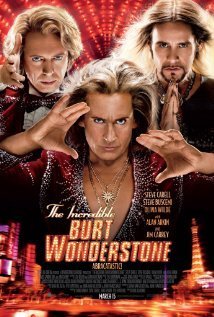 Identity Thief (2013). Despite that I know and love people who enjoyed this movie, I am going to say that it was a stinker. I thought it was pretty terrible for lots of different reasons: it was too slow; it was too crass; it was too far-fetched; it wasn’t even very funny. You want to see a new comedy, stick to this next one.
Identity Thief (2013). Despite that I know and love people who enjoyed this movie, I am going to say that it was a stinker. I thought it was pretty terrible for lots of different reasons: it was too slow; it was too crass; it was too far-fetched; it wasn’t even very funny. You want to see a new comedy, stick to this next one.
The Incredible Burt Wonderstone (2013). Steve Carell, Steve Buscemi, Jim Carey, in a slightly dark, clean comedy. What’s not to like? I really enjoyed chuckling at this flick, one I had never even heard of before seeing it in the Lufthansa offerings. Not a ton to say, except that if you too have not heard of it, it is about the turf wars between old-style, casino-spotlighting magicians and the new-style, freak-you-out, street magicians. Jim Carey’s character is great.
Jack the Giant Slayer (2013). Yeah, it was okay. Too gory for my kids, but entertaining enough for a summer blockbuster. Not like you are surprised by what happens at any given time, but the final product is seamless and shiny, ready to reel in the dough.
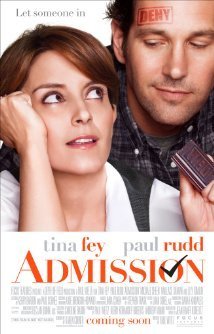 Admission (2013). See this instead of Identity Thief. A decent movie with plenty of heart. You’re not going to go laughing down the aisle, but you will probably enjoy the movie. And Tina Fey is still the belle of Hollywood, isn’t she?
Admission (2013). See this instead of Identity Thief. A decent movie with plenty of heart. You’re not going to go laughing down the aisle, but you will probably enjoy the movie. And Tina Fey is still the belle of Hollywood, isn’t she?
Downton Abbey Season Three (2013). Whoa. First of all, we all know that I love Downton Abbey with the best of ‘em. Even Kevin loves Downton Abbey. However, however, however, I am sad to report that the ending of season three was terrible. I don’t want to launch into some huge explanation and therefore heap on the spoilers, but I do have a huge explanation I could give. Let’s just suffice it to say that every single plot line and twist in the final episode of season three had been done before. Go ahead. Give yourself time to think about it. It’s as if the head writer got the flu and the other writers just decided on a mash-up. Which is why you were so disappointed when the final ka-pow! at the very last minute left you feeling irritated… it was redundant and therefore completely unnecessary. Ug. And yet I will be giving Downton a chance again next season, in hopes that they all can recover from the disaster before they do the whole Brisith one-two-end-the-series punch thing.
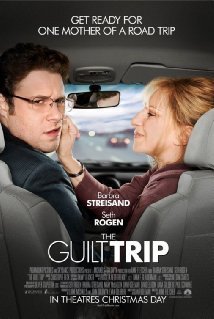 The Guilt Trip (2012). I am getting repetitive here, but another fine comedy. You know what’s coming, at least for the most part, but you enjoy the one-liners, the relationship and the relational aspect of the movie. You believe Babs is Seth Rogan’s mom. You laugh. You sigh. You cringe at how fast your own son is growing up and wonder what your mother-son road trip will look like in twenty years… well, maybe that’s just me. Then you turn it off having some little nugget of wisdom (or just enjoyment) tucked away.
The Guilt Trip (2012). I am getting repetitive here, but another fine comedy. You know what’s coming, at least for the most part, but you enjoy the one-liners, the relationship and the relational aspect of the movie. You believe Babs is Seth Rogan’s mom. You laugh. You sigh. You cringe at how fast your own son is growing up and wonder what your mother-son road trip will look like in twenty years… well, maybe that’s just me. Then you turn it off having some little nugget of wisdom (or just enjoyment) tucked away.
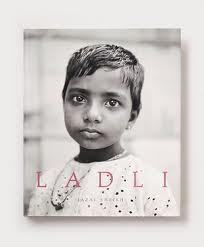 Fazal Sheikh’s Ladli (2008). My mother-in-law picked this non-fiction picture book up a yard sale or a used book store and had it waiting for me to read on my vacation. Overall, I would recommend the book simply because it is full of valuable information, interesting stories, and beautiful photos. My one caveat: it could have been much better. At any rate, if you are interested in humanitarian, womens’, or human trafficking issues, you will want to take a look at this book (full of stories about selective-abortion/female feticide in India and the cultural repercussions thereof).
Fazal Sheikh’s Ladli (2008). My mother-in-law picked this non-fiction picture book up a yard sale or a used book store and had it waiting for me to read on my vacation. Overall, I would recommend the book simply because it is full of valuable information, interesting stories, and beautiful photos. My one caveat: it could have been much better. At any rate, if you are interested in humanitarian, womens’, or human trafficking issues, you will want to take a look at this book (full of stories about selective-abortion/female feticide in India and the cultural repercussions thereof).
 Lowland Hum’s Native Air (2013). I have supported exactly three bids on Kickstarter over the past year. One was for the YA book series Wollstonecraft, and two were for low-energy, alternative couples bands Trouvere and Lowland Hum. Lowland Hum has finally delivered on their promise of a free album to their supporters, and I am happy to say that it is a good one. While part of their allure is their approach to full-sensory entertainment (as in burning smelly candles and handing out things at their shows), you cans still enjoy their music without it. What my mom would call “college music” because of it’s mellowness, blossoms out of real calm, solid talents and lots of hard work and love, even if they aren’t totally polished, yet (or actually, it’s not that they are not polished as much as it is they drop off each song before it has been developed properly. Shortness is part of it, but so is a lack of exploration of the song, lack of immersion/development). If you like folk rock or folk or “college music,” you should check them out.
Lowland Hum’s Native Air (2013). I have supported exactly three bids on Kickstarter over the past year. One was for the YA book series Wollstonecraft, and two were for low-energy, alternative couples bands Trouvere and Lowland Hum. Lowland Hum has finally delivered on their promise of a free album to their supporters, and I am happy to say that it is a good one. While part of their allure is their approach to full-sensory entertainment (as in burning smelly candles and handing out things at their shows), you cans still enjoy their music without it. What my mom would call “college music” because of it’s mellowness, blossoms out of real calm, solid talents and lots of hard work and love, even if they aren’t totally polished, yet (or actually, it’s not that they are not polished as much as it is they drop off each song before it has been developed properly. Shortness is part of it, but so is a lack of exploration of the song, lack of immersion/development). If you like folk rock or folk or “college music,” you should check them out.
We also finished up the second season of Supersizers Go…, which I sung praises to a few months ago. I still like it, would watch a lot more, but was bummed to find that what started in season one as a whole-hog experiential week of something in England’s history has turned into a multi-experiential week of sometime in British or pre-British history. See the difference? Oh well, then, see it for yourself.


Bring in the Mediocre Blockbusters
Basically, I was away from my life and from my work from mid-June to mid-August. That means that July was not a month for a lot of progress on books or book sales, and yet there were some things happening. I had one guest appearance on a blog while I was away and, by the miracle of blog scheduling, I even posted an entry here at The Starving Artist (and a few elsewhere). Plus, I started out the month learning that I won my third honorable mention in general fiction, this time with the Hollywood Book Festival. Apparently, they think my book would make a good movie. That’s always exciting, although a first place would be lovely, too.
Mind you, I was still reading my heart out, and amassed book reviews in my upper story even though not down on virtual paper (yet). So look forward to several reviews in quick succession, some of which may even appear backwards in time.
The other thing I was doing? Watching in-flight movies. So here is what I have to offer for entertainment, in July:
 Identity Thief (2013). Despite that I know and love people who enjoyed this movie, I am going to say that it was a stinker. I thought it was pretty terrible for lots of different reasons: it was too slow; it was too crass; it was too far-fetched; it wasn’t even very funny. You want to see a new comedy, stick to this next one.
Identity Thief (2013). Despite that I know and love people who enjoyed this movie, I am going to say that it was a stinker. I thought it was pretty terrible for lots of different reasons: it was too slow; it was too crass; it was too far-fetched; it wasn’t even very funny. You want to see a new comedy, stick to this next one.
The Incredible Burt Wonderstone (2013). Steve Carell, Steve Buscemi, Jim Carey, in a slightly dark, clean comedy. What’s not to like? I really enjoyed chuckling at this flick, one I had never even heard of before seeing it in the Lufthansa offerings. Not a ton to say, except that if you too have not heard of it, it is about the turf wars between old-style, casino-spotlighting magicians and the new-style, freak-you-out, street magicians. Jim Carey’s character is great.
Jack the Giant Slayer (2013). Yeah, it was okay. Too gory for my kids, but entertaining enough for a summer blockbuster. Not like you are surprised by what happens at any given time, but the final product is seamless and shiny, ready to reel in the dough.
 Admission (2013). See this instead of Identity Thief. A decent movie with plenty of heart. You’re not going to go laughing down the aisle, but you will probably enjoy the movie. And Tina Fey is still the belle of Hollywood, isn’t she?
Admission (2013). See this instead of Identity Thief. A decent movie with plenty of heart. You’re not going to go laughing down the aisle, but you will probably enjoy the movie. And Tina Fey is still the belle of Hollywood, isn’t she?
Downton Abbey Season Three (2013). Whoa. First of all, we all know that I love Downton Abbey with the best of ‘em. Even Kevin loves Downton Abbey. However, however, however, I am sad to report that the ending of season three was terrible. I don’t want to launch into some huge explanation and therefore heap on the spoilers, but I do have a huge explanation I could give. Let’s just suffice it to say that every single plot line and twist in the final episode of season three had been done before. Go ahead. Give yourself time to think about it. It’s as if the head writer got the flu and the other writers just decided on a mash-up. Which is why you were so disappointed when the final ka-pow! at the very last minute left you feeling irritated… it was redundant and therefore completely unnecessary. Ug. And yet I will be giving Downton a chance again next season, in hopes that they all can recover from the disaster before they do the whole Brisith one-two-end-the-series punch thing.
 The Guilt Trip (2012). I am getting repetitive here, but another fine comedy. You know what’s coming, at least for the most part, but you enjoy the one-liners, the relationship and the relational aspect of the movie. You believe Babs is Seth Rogan’s mom. You laugh. You sigh. You cringe at how fast your own son is growing up and wonder what your mother-son road trip will look like in twenty years… well, maybe that’s just me. Then you turn it off having some little nugget of wisdom (or just enjoyment) tucked away.
The Guilt Trip (2012). I am getting repetitive here, but another fine comedy. You know what’s coming, at least for the most part, but you enjoy the one-liners, the relationship and the relational aspect of the movie. You believe Babs is Seth Rogan’s mom. You laugh. You sigh. You cringe at how fast your own son is growing up and wonder what your mother-son road trip will look like in twenty years… well, maybe that’s just me. Then you turn it off having some little nugget of wisdom (or just enjoyment) tucked away.
 Fazal Sheikh’s Ladli (2008). My mother-in-law picked this non-fiction picture book up a yard sale or a used book store and had it waiting for me to read on my vacation. Overall, I would recommend the book simply because it is full of valuable information, interesting stories, and beautiful photos. My one caveat: it could have been much better. At any rate, if you are interested in humanitarian, womens’, or human trafficking issues, you will want to take a look at this book (full of stories about selective-abortion/female feticide in India and the cultural repercussions thereof).
Fazal Sheikh’s Ladli (2008). My mother-in-law picked this non-fiction picture book up a yard sale or a used book store and had it waiting for me to read on my vacation. Overall, I would recommend the book simply because it is full of valuable information, interesting stories, and beautiful photos. My one caveat: it could have been much better. At any rate, if you are interested in humanitarian, womens’, or human trafficking issues, you will want to take a look at this book (full of stories about selective-abortion/female feticide in India and the cultural repercussions thereof).
 Lowland Hum’s Native Air (2013). I have supported exactly three bids on Kickstarter over the past year. One was for the YA book series Wollstonecraft, and two were for low-energy, alternative couples bands Trouvere and Lowland Hum. Lowland Hum has finally delivered on their promise of a free album to their supporters, and I am happy to say that it is a good one. While part of their allure is their approach to full-sensory entertainment (as in burning smelly candles and handing out things at their shows), you cans still enjoy their music without it. What my mom would call “college music” because of it’s mellowness, blossoms out of real calm, solid talents and lots of hard work and love, even if they aren’t totally polished, yet. If you like folk rock or folk or “college music,” you should check them out.
Lowland Hum’s Native Air (2013). I have supported exactly three bids on Kickstarter over the past year. One was for the YA book series Wollstonecraft, and two were for low-energy, alternative couples bands Trouvere and Lowland Hum. Lowland Hum has finally delivered on their promise of a free album to their supporters, and I am happy to say that it is a good one. While part of their allure is their approach to full-sensory entertainment (as in burning smelly candles and handing out things at their shows), you cans still enjoy their music without it. What my mom would call “college music” because of it’s mellowness, blossoms out of real calm, solid talents and lots of hard work and love, even if they aren’t totally polished, yet. If you like folk rock or folk or “college music,” you should check them out.
We also finished up the second season of Supersizers Go…, which I sung praises to a few months ago. I still like it, would watch a lot more, but was bummed to find that what started in season one as a whole-hog experiential week of something in England’s history has turned into a multi-experiential week of sometime in British or pre-British history. See the difference? Oh well, then, see it for yourself.


July 24, 2013
Book Review: A Doll’s House
“A Doll’s House,” by Henrik Ibsen (1879), read from Oxford World’s Classics Henrik Ibsen: Four Major Plays (1981), transl. by James McFarlane and Jens Arup. Also, “Ghosts” (1881), “Hedda Gabler” (1890), and “The Master Builder” (1892).
I can’t say that I enjoyed these plays too much. Ibsen and I diverge too much in our basic ideas of the world. What he calls bravery, I call cowardice, and vice versa. What he calls virtue, I call selfishness, and again vice versa. But I will try to assess them from a literary perspective, as well as a taste one, especially understanding that many of his morals are the morals of my own society.
Henrik Ibsen was a Norwegian man born in 1828, who, as Oxford World’s Classics puts it, was a playwright with “a period of sustained creative endeavor unparalleled in the history of modern theater and one which gave a whole new impetus and direction to the drama of the twentieth century.” Whew. His most famous play, “A Doll’s House,” was published in 1879, and began his career as a public menace, the object of outrage. His plays started the stage in Scandinavia, where they met with wide public debate, and in Germany the ending was (forced to be) re-wrote. It took until 1889 for the play to reach London, where its fame preceded it. Amid criticism and hostility were support and love, and Ibsen would continue as a public topic of polarized debate for his career. Ibsen knew his plays, their topics, and his “stark” treatment of them were inciting, but he sought truth at all cost, and dealt openly with subjects like commercial hypocrisy, religious intolerance, political expediency, conventional morality, and established authority (including man’s authority over woman). As time continued, he moved from the public sphere of conflict to a personal one, where his characters increasingly wrestled with temperamental and sexual incompatibility, magnetism, force, their unconscious mind, and dreams and visions. Overall, his writing was not only an impetus for social change, but also a game-changer in the arena of theater, where he excelled at using subtleties in language to an extent no one before had ever done before.
The “period of sustained creative endeavor unparalleled in the history of modern theater” began in 1877 and lasted until 1892. The four plays I read were pairs of plays at the beginning (almost) and end of this period. “A Doll’s House” was meant to culminate in “Ghosts,” and “Hedda Gabler” and “The Master Builder” were–as I have heard the phrase before–spiritual sisters.
I have been doing a lot of thinking about plays as literature, lately (which may be revisited when I review “Hamlet”). It is not quite adequete to read a play, exactly. I would think that in almost all circumstance, plays are truly realized when they are performed. However, as this is a book blog and plays are often included in lists of novels/great literature, I will review them as I would a novel. If I easily encounter performances of them, I will review those as well. Almost any decent play can become great in the hands of a masterful director, actors, and set artist, and likewise can fall flat without them.
As for Ibsen’s plays, I find his characters to be unbelievable, especially one of the shining stars of his fame and accomplishments, Nora Helmer. I guess what I find most obnoxious about these characters is the speed with which they do things, which could be blamed on the necessity of story and play-writing, or it could be that the characters do not show significant glimmers of what they are to suddenly and so surprisingly become. Nora, for example, is this flitting, domestic plaything (thus the title) for nine-tenths of the play, unable to see her own mistakes and the seriousness of the looming catastrophe ahead. Then, all of a sudden, she is a most advanced, thoughtful, determined individual, come to drastic acts with absolutely no passion and able to express her inmost feelings and will to her husband without missing a beat. I’ve been in arguments. They don’t go like that.
Ibsen has also said of his own work that his plays do not make statements, they just pose questions. It is unfortunate that authors can not know their own work or impact as well as they might like (me and everyone else included), but I don’t buy this assessment for a second. It is historically interesting that he considered his plays questions, but they are very clearly works of value statements and modes for societal change (which is exactly what they became.) With lines like “If I’m ever going to reach any understanding of myself and the things around me, I must learn to stand alone,” would you believe his plays are unbiased vignettes, wondering about human nature, and nothing more?
And finally, I have to come back to this matter of taste. Ibsen, as might have been necessary in someone pushing toward individualism and equality in the 1800s, makes selfishness the knight in shining armor of his plays. I can’t enjoy story lines where such individuality is honored above duty and community and a moral compass; it’s just not something I believe and so I find Ibsen’s heroes and heroines unpalatable. In some stories, that’s okay, but Ibsen’s plays are constructed around the ideal, a pleasurable inoculation of them, so it’s much harder than having, for example, a novel where one of the characters commits suicide (a favorite of his) and another runs away (another favorite), and the novel’s judgement remains unclear or backward from what the reader might have picked. Let’s face it; we expect the just desserts of characters to line up with our morals, or else we have this thing called dissatisfaction. Only a very talented author can make characters so complex that we are willing to stay judgement for love of the character or some other dearly held ideal: that’s when literature can bend our future ideas, not when we are presented with characters that shock us and then merrily get the opposite of what we think they deserve.
For all that, I enjoy the story lines of some of his plays, especially “A Doll’s House.” Others were much less dramatic and, I would go so far, boring (namely “Ghosts”). Again, it’s only historically interesting Ibsen thought “Ghosts” was the culmination of “A Doll’s House,” because “House” is clearly the masterpiece of the two, better in every way I can think of. It’s dramatic. It’s interesting. It has several different plots interweaving on one stage, in one set, in just a few virtual days.
Like I said, I really enjoy the story of this play, but I find the outcome less than satisfying. I was also astonished by how many lines and ideas have become part of our culture. To wit (just from Nora’s lines in the last scene): “I have never understood you, either–until tonight,” “I’ve been greatly wronged, Torvald,” “You two never loved me,” “It’s your fault that I’ve never made anything of my life,” “I thought I was [happy], but I wasn’t really,” “I must take steps to educate myself,” “That’s something I must do on my own,” “I must learn to stand alone,” “All I know is that this is necessary for me,” “I have another duty equally sacred … My duty to myself,” “I have to think things out for myself,” “I believe that first and foremost I am an individual,” I don’t really know what religion is,” and “But I can’t help it. I don’t love you anymore.” It’s probably difficult to remove ourselves enough from the twenty-first to the nineteenth century to see what kind of statements these were, back then, but it seems that I am still hearing the echoes of Ibsen every day, at all levels of our society. That is quite something.
“Miserable as I am, I’m quite ready to let things drag on as long as possible. All my patients are the dame. Even those with moral affliction are no different” (p18).
“Ah, Torvald, you are not the man to teach me to be a good wife to you” (p81).
Sorry, but I found this play to be a lot of talking with no purpose. Boring. I can barely remember what it wasn’t about.
“My dear lady, there are many occasions in life when one must rely on others. That’s the way of the world, and things are best that way. How else would society manage?” (p102).
“All of this demanding to by happy in life, it’s all part of this same wanton idea. What right have people to happiness? No, we have our duty to do, Mrs. Alving” (p113).
Alright, back to interesting. Again, can’t agree with half of what Ibsen implies, but at least there is a vibrant plot(s) here. I imagine you could put on quite a show with this play.
“Because we men, you know, we’re not always so firm in our principles as we ought to be” (p237).
“I’d sooner die! / People say such things, but they never do them” (p262).
“One generally acquiesces in what is inevitable” (p262).
A mildly interesting play with somewhat interesting characters. Funny that “The Master Builder” is considered the culmination of “Hedda Gabler,” when “Gabler” was far superior.
“It’s fantastic the number of devils there are in the world you never even see, Hilde!” (p323).
“Or if one had a really tough and vigorous conscience. So that one dared to do what one wanted” (p323).
In a way, reading Ibsen is like seeing ourselves in a cracked, Victorian mirror. If, indeed, these plays were just questions, then my questions are these: Is Nora the heroine? Or Kristine? And does “Hedda Gabler” have a hero at all?
*****
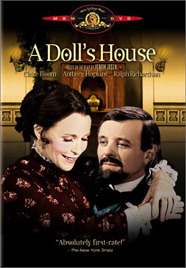 Despite plenty of online photos of productions of these plays, I found only one video I could get my hands on, which is the Anthony Hopkins version of A Doll’s House (1973). And actually, I really enjoyed it. I thought that what Hopkins did for Torvald was a sight to behold, making the viewer sympathetic to him. And Claire Bloom actually welds Nora’s flightiness and her final conclusions together. It’s really wonderful acting. My only disappointment was the age of Doctor Rank. The guy played it well, but he was much too old to create much sexual tension between him and Nora (although they managed it fairly well, anyhow). If you are interested in plays or Ibsen, I would recommend this one. (It doesn’t view like a modern movie, as much).
Despite plenty of online photos of productions of these plays, I found only one video I could get my hands on, which is the Anthony Hopkins version of A Doll’s House (1973). And actually, I really enjoyed it. I thought that what Hopkins did for Torvald was a sight to behold, making the viewer sympathetic to him. And Claire Bloom actually welds Nora’s flightiness and her final conclusions together. It’s really wonderful acting. My only disappointment was the age of Doctor Rank. The guy played it well, but he was much too old to create much sexual tension between him and Nora (although they managed it fairly well, anyhow). If you are interested in plays or Ibsen, I would recommend this one. (It doesn’t view like a modern movie, as much).
*I did not feel like continuing with Ibsen into other works, at this time, but there are more of his plays in my (very) long term reading plan. Look for them much, much, much later.


July 17, 2013
Book Review: Fortress of Solitude
 Fortress of Solitude, by Jonathan Letham, the National Bestseller published in 2003 by Vintage Books.
Fortress of Solitude, by Jonathan Letham, the National Bestseller published in 2003 by Vintage Books.
In 2003, I was no longer in college, nor was I writing full time yet. In fact, I was working as a receptionist at an inner city junior high, crying on my drive home, recuperating in the evenings listening to my husband play video games and staring at the wall, planning a first child. Not a time when I was reading books acclaimed by everyone from The New York Times to Oprah to Rolling Stone. Plus, even though the idea of the book seemed neat to me, you probably couldn’t have paid me to get all the way through, before I came up with my crazy read-1200 books idea.
But here I am. Now writing and blogging full time, my once-only-dreamed-of kids both off to school, and I am on book 28 of my first year of reading-through-all-the-top-100s. On the randomizer, this book popped up 7th, but got moved to 13th while I read more of one author. I won’t use the expression Letham’s protagonist would use. I’ll just say, “Whatever.”
Let’s start with the positives, and the reasons I think Letham must have gotten so much attention (besides subject matter?). He is very good with words. At times, his prose is absurdly beautiful, playful, and searing. His images tend to hang in the air like sun streaks stuck on your retina. So that’s high praise and it lasts the whole book long. However.
The plot didn’t start until somewhere after 100 pages into the book. Like I said before, there is no way I would have stayed with the book without something external to compel me. Now, I know that this is ironic criticism coming from me, when Benevolent also doesn’t get going plot-wise for at least a few chapters. I’m a character writer, I plead. But is Letham? I don’t think so. He’s more of an image writer or an idea writer, so we need great characters and/or a great story to make us read. I can’t say I found his characters to be anything more than flatly despicable and cocky. And then that plot which didn’t get started until page 100? More on this in a minute.
This is my main impression of the book: I felt just like someone had handed me a freshly-written novel and I was the agent or editor deciding what to do with it. If all that had been real, I would have handed the manuscript back to Letham and said, “You’ve got heaps of potential, but we have some serious work to do here before we take the world by storm.” For one, the book should have been about 50 per cent its length. For two, Letham tried to cover too much. Was the book about the time of life Dylan spent in Brooklyn? Or about what happened because of it, as an adult in California? Was his college career central? Or his relationships with blondes and black women? For three, when Letham gets going with poetic prose, he needs to finish his tirade and then go chop-chop. Pick the metaphor (or phrase) you like best, man. That’s enough! Fourth, we’ve got to think seriously about the direction of this book. It’s chronological, right? Except where you get Dose’s back-story? Should we start at the end, instead? Tell from the adult voice? Or look ahead, as a kid, and imply the ending? Shouldn’t we follow any of the other characters outside of Dylan’s narration? Whatever. Lastly and relatedly, whose story is this? Is it just Dylan’s? Then cut everyone else’s. If it’s a plot-driven group story, come out of Dylan’s skin. I’m just sayin’. I found so many cardinal mistakes, I was surprised someone didn’t demand he change those major flaws before handing him the writing world.
And back to the plot issues; what was with the different sections? It took so long to get the plot going, but when it did, I found myself enjoying it and then I came to the end of the first section (at page 289). The end! I had absolutely no use for the second section or for most of the third/last section. The final ending of the book I thought worked awesome (except for a major flaw with changing the ring’s power without any driving force), but I wanted desperately for it to tie more to the first section and to see it coming from page one. I guess I would say pacing and unity were huge issues for me, with this book. Perhaps this is two books. Or three.
And I also have a pet peeve with making kids too old, mentally and psychologically, for their age. Sure, occasionally there is the extreme case, but Dylan was no Superman (har har). Plus, he had that nasty habit of being uber-insightful and yet completely blind. And did he ever change in the least? Did any of the characters ever change in the least? I pretty much hated Dylan, even though he was a victim. Perhaps if Letham had just told the story without reminders and exposition, it would have helped.
And I have to mention that I found the whole homoerotic thing to be unnecessary, especially because he kept saying it wasn’t homosexual. What am I missing, here? In fact, all of the sexual content of the book was distracting, to me because the nature of the book and the story was not at all sexual. I know growing boys deal with sex like 100 times a day, but that doesn’t mean all stories about growing boys have to include explicit sexual tension. I would have liked to just stick with friends, superheroes, safety versus danger, and moms. That’s plenty.
Read it if you want. I wouldn’t recommend it, really, but I would recommend sticking around to see if Letham will come up with a book that contains both his wonderful writing and a heaping measure of restraint and craft. At the very least, I can say that I was surprised by this book, and that I plan to learn a lot from it.
“She was wild with information he couldn’t yet use: Nixon was a criminal, the Dodgers moved to California, Chinese food gives you a headache…” (p11).
“Nobody cared, everybody yelled sometimes seemed to be the verdict” (p16).
“Maybe to perfect a thing was to destroy it” (p22).
“They gathered wide-eyed as though warming at a campfire of their own awe” (p47).
“‘…the world is nuttier than a fruitcake. Run if you can’t fight, run and scream fire or rape, be wilder than they are, wear flames in your hair, that’s my recommendation’” (p52).
“Possibly mentioning anyone’s moms out loud, even your own, was miscalculation enough to blow an afternoon” (p94).
“Four black kids dancing like startled spiders in the flow of a wrenched-open hydrant on Nevins and Bergen” (p103).
“It wasn’t for children, seventh grade” (p116).
“…well, they’re projects, their own law, like meteors of crime landed in the city’s midst, still unapproachably hot” (p135).
“Standing at a mirror counting how many buttons up from the floor to undo, nothing’s accidental” (p245).
“The key to mostly anything is pretending your first time isn’t” (p259).
“Someone’s betrayed someone but you can’t say who. Someone’s flying and it isn’t you” (p272).
“Everything was presented with a passive-aggressive flourish, as though we probably weren’t savvy enough to appreciate the oregano-heavy garlic bread, the individual bowls for olive pits, the starched napkins shoved into our wine glasses, or the waiter’s strained enunciation of a long list of specials” (p347).
“‘What do you want me to say?’ I needed orange juice, a toothbrush, a blood transfusion, a Bloody Mary, Abigale Ponders, Leslie Cunningham, a Thneed, someone to watch over me, a miracle every day–anything but a moment of truth between myself and Zelmo Swift. I needed a volume knob on Zelmo Swift” (p361).
“Invisibility was what every superhero really had in common. After all, who’d ever seen one?” (p410).
“I walked an invisible map of incidents, shakedowns, hurled eggs, pizza muggings, my own stations of the cross …. The fact that I could see Gowanus glinting under the veneer wasn’t important, wasn’t anything more than interesting” (p427).
“Any connection was a good one, here in the woods” (p482).
“What age is a black boy when he learns he’s scary?” (p490).
“I was humbled, as I ought to have been, to see what varieties of life could exist between the arrogant, oblivious coasts” (p504).


July 13, 2013
Laurels
July 5, 2013
The All-Important Character
One of the things I have learned about writing while writing is that it often takes writing to learn about writing. Make sense? You know, I like to read about writing, everything from plotting journals to autobiographies of writers (and magazines, oodles of magazines). But in some ways, there is nothing like writing, and then editing, and then publishing, and then selling, to really teach you how to do those things. Like an apprenticeship, without the apprentisor.
It’s also really hard to know–from where you stand–what your writing strengths and weaknesses are. When I was writing on Benevolent, it occurred to me that I had never written a novel before. When I was editing it, I realized I had never edited a novel before. I had done plenty of poems, short stories, and essays, but I understood novels to be a different game. The longevity. The continuous story. The consistency. All new. Which is why, I suppose, plenty of authors don’t publish their first books and why it’s sort of weird that the majority of us do. I mean, what kind of crazy runs the first time in a sponsored marathon or XXX. But maybe that’s not fair. After all, it is unlikely an architect has ever built an actual building before the first time. They just train (and apprentice) and do smaller projects until… wham! Building! Novel!
Even after I had written the whole novel, edited it, and sent it to the press, I wondered. You get so close to a thing and it is hard to see. Was I any good at a long story line? Was my dialogue believable?
One of the surprises of my life has been one of the most common responses to Benevolent: “I love you characters! I want to hear more about them.” I think when I was writing and editing I concentrated more on the story than on the people, and wondered what sort of character-writer I was. Turns out, I am a character writer. The characters drive my story, making people believe in them and love them. The characters in Benevolent orchestrate the reader’s reactions, their feelings, and their rating. Who knew? Don’t look at me; I have never done this before.
Characters are quite important. Even if you are a plot writer (which lots of genre writers are), you still have to have good, solid characters (and vice versa: as a character writer, no one will read me without an interesting, compelling story). But how does one learn to take a character from page one all the way to page 450 and still have them be the same character, relate-able to real people, with a fatal flaw or two, and having grown in some way? And could you do it? Do it well?
I’m not sure there’s any other way to find out than to do it. And from there, you need to listen to your writing group and your editor and whatever instructor you may have around. Then use all those writing tools you have gleaned from courses, books, and magazines. You can get better, that we already know. Find your sparkle and buff it to a shine.
Ever since I realized everyone was loving my characters, I have noticed everywhere that many characters are as flat as a pancake (and even more tired than that simile). I didn’t like a movie? I blame it on the characters. A TV series flops? It’s the characters. And how many times this year have a said about a book, “There are just no lovable characters.” Because I think that’s one of the things I have really gotten from this process; you can have a super villain (I really don’t), or even a super flawed hero, but a story can’t endure without a lovable character.


July 1, 2013
Amazing Entertainment
Yes, yes. I am overseas helping orphans. And yet here I am, giving you a June media synopsis. Chalk it up to the amazing power of scheduling blog entries. Or the universality of the internet. Which one is it? You may never know…
Nothing going on this month much with Benevolent. I have won a second honorable mention for an international book competition, which is exciting and barely noticeable, unfortunately. Just hanging around waiting for Gwyneth Paltrow to plug it, and writing on The Family Elephant’s Jewels.
So to the movies and TV for the month of June.
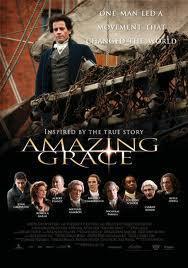 Amazing Grace (2006). We saw this movie right at the start of June, in someone else’s home. Despite some other strong standings, I would say Amazing Grace took the cake this month. It was a wonderful movie. You sort of wonder why it wasn’t more popular, and then you kind of understand. In some ways, it was similar to Amadeus in it’s historical scope. But then it is religious, at heart. I also happened to be reading a book at the time (Disraeli’s Sybil) that covered roughly the same time period and much of the same material (Wilberforce was even mentioned in the book), so I was extra intrigued. But just plain good acting and good story and lots to take away.
Amazing Grace (2006). We saw this movie right at the start of June, in someone else’s home. Despite some other strong standings, I would say Amazing Grace took the cake this month. It was a wonderful movie. You sort of wonder why it wasn’t more popular, and then you kind of understand. In some ways, it was similar to Amadeus in it’s historical scope. But then it is religious, at heart. I also happened to be reading a book at the time (Disraeli’s Sybil) that covered roughly the same time period and much of the same material (Wilberforce was even mentioned in the book), so I was extra intrigued. But just plain good acting and good story and lots to take away.
M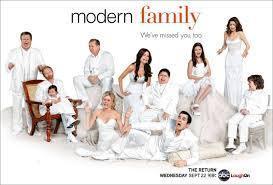 odern Family (TV series, 2009-). I have to admit that I loosely follow Modern Family, and spent the beginning of this month catching up, a bit. I will not defend myself from any naysayers, except to say that it is such a hilarious portrayal of modern, middle-to-upper-class suburban life in America, PG13, and with lots of heart. The laugh-per-minute meter is way up there with this one.
odern Family (TV series, 2009-). I have to admit that I loosely follow Modern Family, and spent the beginning of this month catching up, a bit. I will not defend myself from any naysayers, except to say that it is such a hilarious portrayal of modern, middle-to-upper-class suburban life in America, PG13, and with lots of heart. The laugh-per-minute meter is way up there with this one.
New Girl (TV series, 2011-). I tried this one out because I like Zooey Deschanel. Actually, I had tried it out once before, had not been impressed, but then saw that it had fairly good ratings and was experiencing some longevity, so I gave it a second shot. Still not impressed. Of course, Jessie’s character is cute and you want the guy to get the girl and all that, but I don’t find it very funny and I very much find it typical and depraved, in the run-of-the-mill sense.
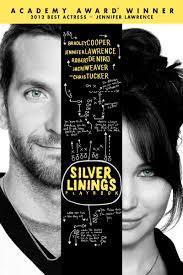 Silver Linings Playbook (2012). We were anxious to see this film, because we know what it’s like to live with bipolar disorder, around here. I was personally dubious, since the characters are both struggling with mental illness of some sort (which seems to beg for disaster, from where I stand). In fact, the writer of this screenplay might find fault with my even regarding it as an illness, since the movie really concentrates on the positive side of the bipolar personality. But that might not be fair, because the father in the movie was more ill than any of the other characters, and his portrayal as an OCD was truly convincing. As was Bradley Cooper’s portrayal as struggling with a mild case of bipolar. Straight off from the beginning, he was dead-on with his is-this-normal-or-is-something-amiss. Seriously. If you know someone with bipolar, and know them well, you can identify with this almost imperceptible idiosyncrasy. The movie is very sweet in the end, obviously. But despite all its plaudits, I thought the whole silver linings thing was about as delusional as anything. In other words, the movie ended up unfulfilling, for me, even though enjoyable.
Silver Linings Playbook (2012). We were anxious to see this film, because we know what it’s like to live with bipolar disorder, around here. I was personally dubious, since the characters are both struggling with mental illness of some sort (which seems to beg for disaster, from where I stand). In fact, the writer of this screenplay might find fault with my even regarding it as an illness, since the movie really concentrates on the positive side of the bipolar personality. But that might not be fair, because the father in the movie was more ill than any of the other characters, and his portrayal as an OCD was truly convincing. As was Bradley Cooper’s portrayal as struggling with a mild case of bipolar. Straight off from the beginning, he was dead-on with his is-this-normal-or-is-something-amiss. Seriously. If you know someone with bipolar, and know them well, you can identify with this almost imperceptible idiosyncrasy. The movie is very sweet in the end, obviously. But despite all its plaudits, I thought the whole silver linings thing was about as delusional as anything. In other words, the movie ended up unfulfilling, for me, even though enjoyable.
Dj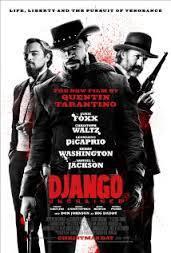 ango Unchained (2012). Well, if you like Kill Bill, you will probably like this (just minus the kung fu, plus the western). It’s a solid movie, alright, but man is it chock-full of stylized gore and violence. Like the director, like the movie. There is blood just splashing everywhere.
ango Unchained (2012). Well, if you like Kill Bill, you will probably like this (just minus the kung fu, plus the western). It’s a solid movie, alright, but man is it chock-full of stylized gore and violence. Like the director, like the movie. There is blood just splashing everywhere.
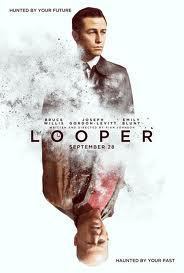 Looper (2012). Kevin is always a sucker for a time travel movie. He’s been wanting to see this for ages (or since last year), so he just popped home with it one day and said that’s what we were doing after kid-down. I was distressed to find a whole lot of violence and sex, but the premise was really creative and the execution even better. Great story, seamless acting, and a fun exploration of time travel (just don’t think too hard). And something else about this movie that you never hear from me: it had me guessing till the end.
Looper (2012). Kevin is always a sucker for a time travel movie. He’s been wanting to see this for ages (or since last year), so he just popped home with it one day and said that’s what we were doing after kid-down. I was distressed to find a whole lot of violence and sex, but the premise was really creative and the execution even better. Great story, seamless acting, and a fun exploration of time travel (just don’t think too hard). And something else about this movie that you never hear from me: it had me guessing till the end.
Oz the Great and Powerful (2013). In some senses, this movie was just what it should be: full of saturated color, crazy characters, and good versus evil with some in-between. I didn’t find James Franco’s acting as horrifying as some complained of (I thought the China Girl was more mediocre). What I did find distracting was 1) the slightly outdated CG and 2) the pacing. There were scenes that seemed so slow to me. I even found both Oz’s and Glinda’s talking to be slow. The promise of the beginning credits just didn’t flower into a wonderful movie.
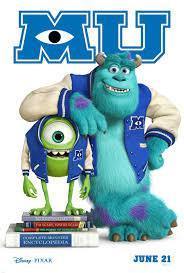 Monsters University (2013). We saw this movie at a cheap theater, in the almost-last row, on a stormy night. Also, the seats in the theater squeaked quite a bit. However, it was a terrific movie. I really mean it. You laughed, you cringed, you were surprised, and everything all fit together in a wonderfully organic way. But that’s not the best part. The CG was amazing! What Sully did for animation hair the first time around, this movie will do for wacky characters walking around in what is unidentifiable as a fictional world. How could that be an imaginary bus? A computer-generated college green? Crazy.
Monsters University (2013). We saw this movie at a cheap theater, in the almost-last row, on a stormy night. Also, the seats in the theater squeaked quite a bit. However, it was a terrific movie. I really mean it. You laughed, you cringed, you were surprised, and everything all fit together in a wonderfully organic way. But that’s not the best part. The CG was amazing! What Sully did for animation hair the first time around, this movie will do for wacky characters walking around in what is unidentifiable as a fictional world. How could that be an imaginary bus? A computer-generated college green? Crazy.


June 26, 2013
Author Review: Jacqueline Wilson
 Dustbin Baby, by Jacqueline Wilson–ahem, Dame Jacqueline Wilson–published in the UK in 2001 by Random House/Doubleday.
Dustbin Baby, by Jacqueline Wilson–ahem, Dame Jacqueline Wilson–published in the UK in 2001 by Random House/Doubleday.
Or at least that was where it started. I had a week before me, during which I was planning and packing for a very big trip, two thick books lined up in the queue (which would be the wooden box between my front door and the couch), and Dustbin Baby already read. I was not that impressed, and took a stroll through the giant spreadsheet of my Best Books to Read, where I found a total of twelve more Jacqueline Wilson books. I was not pumped. But I was surprised.
 Who is this Jacqueline Wilson character that she makes the top 1200 (or so) books thirteen times and yet ceases to impress me? I’ll tell you. She’s a British lady. She has written over sixty-one YA books. She is now some sort of tour de force, complete with a whole online wonderland of games and information, as well as more than a few books-to-movies. She became popular after something like thirty books, when she wrote The Story of Tracy Beaker. Her popularity is thanks almost entirely to the people of England. And here is her schtick: since the 70s, she has been writing short, accessible, encouraging yet realistic books about kids and teens in really tough situations. I ended up gobbling down six more Wilson’s books (that’s all my American library had) before laying out my judgement, and the topics that sampling covered (some of her most lauded, included) were being a foster care child, having a parent with a mental disorder, dealing with the death of a friend, going through parental divorce, being a twin, and being abandoned by your parents.
Who is this Jacqueline Wilson character that she makes the top 1200 (or so) books thirteen times and yet ceases to impress me? I’ll tell you. She’s a British lady. She has written over sixty-one YA books. She is now some sort of tour de force, complete with a whole online wonderland of games and information, as well as more than a few books-to-movies. She became popular after something like thirty books, when she wrote The Story of Tracy Beaker. Her popularity is thanks almost entirely to the people of England. And here is her schtick: since the 70s, she has been writing short, accessible, encouraging yet realistic books about kids and teens in really tough situations. I ended up gobbling down six more Wilson’s books (that’s all my American library had) before laying out my judgement, and the topics that sampling covered (some of her most lauded, included) were being a foster care child, having a parent with a mental disorder, dealing with the death of a friend, going through parental divorce, being a twin, and being abandoned by your parents.
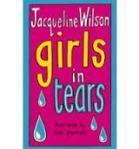 I can’t help but keep thinking about the comment I received about my book from Zack Smith at the local paper: “I’m just going to say it: More coming-of-age novels need stuff like this. Estranged parents and soured relationships can only take you so far.” And yet, I think that Wilson’s books, with their accessibility and their very real and positive outlook, are also important to children. And I don’t know who benefits more: kids who can relate to this stuff, or kids who can learn compassion and understanding. (On the other hand, I think romps into light, airy, and imaginary worlds is also good food for the developing mind.)
I can’t help but keep thinking about the comment I received about my book from Zack Smith at the local paper: “I’m just going to say it: More coming-of-age novels need stuff like this. Estranged parents and soured relationships can only take you so far.” And yet, I think that Wilson’s books, with their accessibility and their very real and positive outlook, are also important to children. And I don’t know who benefits more: kids who can relate to this stuff, or kids who can learn compassion and understanding. (On the other hand, I think romps into light, airy, and imaginary worlds is also good food for the developing mind.)
These are the books I read (some of them in an afternoon), in this order:
Dustbin Baby, 2001
The Illustrated Mum, 1999
Double Act, 1995
The Story of Tracy Beaker, 1991
The Suitcase Kid, 1992
Vicky Angel, 2001
Girls in Tears, 2002
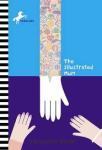 In the end, these books are not really my cup o’ tea, although there was some fun in breezing through them and analyzing them together. And really, I can see the merits of them. Really. Writing-wise, they were unspectacular. Wilson sticks to such straight-forward vocabulary that it can grow flat. At no time was I transported to a grassy hillside. While her characters are rounded out nicely, her plots (I think because of the featureless writing style) leave you wishing for more. With all these terrible, real-life situations and triumphant endings, I ended the last page of the last book wondering why my heart had not soared nor one lonely tear come to my eye. However, the ideas behind the books are solid, and the insight, empathy, and tact with which she writes about them are spot-on. She understands kids–and these kinds of kids (/preteens/teens)–unlike any other author (or even person) I have ever read (met).
In the end, these books are not really my cup o’ tea, although there was some fun in breezing through them and analyzing them together. And really, I can see the merits of them. Really. Writing-wise, they were unspectacular. Wilson sticks to such straight-forward vocabulary that it can grow flat. At no time was I transported to a grassy hillside. While her characters are rounded out nicely, her plots (I think because of the featureless writing style) leave you wishing for more. With all these terrible, real-life situations and triumphant endings, I ended the last page of the last book wondering why my heart had not soared nor one lonely tear come to my eye. However, the ideas behind the books are solid, and the insight, empathy, and tact with which she writes about them are spot-on. She understands kids–and these kinds of kids (/preteens/teens)–unlike any other author (or even person) I have ever read (met).
Six random observations:
 One, I absolutely love the way so many of her main characters see themselves in such negative terms (including, of course, their appearance, but also often their behavior) or even just unrealistic terms, but Wilson never takes the easy way out explaining and patronizing about how they really are beautiful or slender or kind or whatever. The character always slowly, and in a very understated way, discovers something redeemable about themselves, for themselves, and with the tender help of one compassionate person. We need not cue the sappy music.
One, I absolutely love the way so many of her main characters see themselves in such negative terms (including, of course, their appearance, but also often their behavior) or even just unrealistic terms, but Wilson never takes the easy way out explaining and patronizing about how they really are beautiful or slender or kind or whatever. The character always slowly, and in a very understated way, discovers something redeemable about themselves, for themselves, and with the tender help of one compassionate person. We need not cue the sappy music.
Two, these books are for girls. Out of the seven I read, not one of them would be of too much interest to a boy. They were all about girls and written to girls. That’s all.
Three, part of how Wilson does her Wilson-thing is using illustrations (by Nick Sharrat) and other story-telling devices. Yeah, lots of YA books these days use them, too. Like Captain Underpants and Origami Yoda. Wilson uses different techniques in each book, like telling the story through a journal, or starting each chapter with a letter of the alphabet, or hanging the storyline in the structure of a walk through town. Got it?
Four, I also love that she is honest about how kids perspectives are often skewed, especially in that they are often attached where it is unsafe and repelled where it would be good. So many times, her heroine clung to an unhealthy relationship because it was familiar, justifying behaviors and running an internal dialogue of excuses, or separated themselves unwisely from people that could have offered them much better than they were already getting. We adults could take a hint, too.
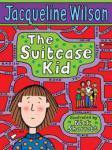 Five, occasionally Wilson’s books bring up the occult or witchcraft, and not necessarily in a fantasy way. I believe she regards it as a type of play-acting, but the line is a thin one. Several of her characters imagine themselves using magic to change things around them or even hurt others. One of the characters imagines a friend who is an “ace” at the occult (turning into a vampire, etc.). Also, Christian belief is seen more in negative terms. The kid characters tend to view religion as worthless and even mock it, while the only positive religious character I read in Wilson’s books was sort of flaky about her religious affiliation to the point that you eventually forgot she was a Christian. (I only just now remembered her because the description of her stiff collar clashing with her lively pants was a stand-out.)
Five, occasionally Wilson’s books bring up the occult or witchcraft, and not necessarily in a fantasy way. I believe she regards it as a type of play-acting, but the line is a thin one. Several of her characters imagine themselves using magic to change things around them or even hurt others. One of the characters imagines a friend who is an “ace” at the occult (turning into a vampire, etc.). Also, Christian belief is seen more in negative terms. The kid characters tend to view religion as worthless and even mock it, while the only positive religious character I read in Wilson’s books was sort of flaky about her religious affiliation to the point that you eventually forgot she was a Christian. (I only just now remembered her because the description of her stiff collar clashing with her lively pants was a stand-out.)
Six, there are movies. I have not seen any of them yet, and have no idea about their availability stateside, but I plan to look into it. \
And now I will give you my brief thoughts on each of the books.
Dustbin Baby was the one which I was referring to when I said I was not that impressed. It remains my least favorite out of the lot. I think the idea was a good one–Wilson is exactly the person who could and should write about the kid who gets left in a dumpster–but the end result was a tad mundane. Also, somehow with the real-time plot and flashback to memories thing, the timing got off.
The Illustrated Mum is a fascinating book for me, not least of all because I too have a family member with bipolar disorder. I found it to be part of the new language and dialogue about this and similar illnesses, where they focus more on the positive elements of the bipolar (or autistic or ADHD or whatever) personality. Being as that may, the mother was an entrancing character, and the struggles of the family so honest and accurate. Besides the slightly cheesy last paragraph, I found this book much better than the first.
 Double Act deals with a subject I can’t say I’ve ever really read about, and that is learning to separate from your twin (or other very close relations or friends; I think that would apply, too). There were moments when the dominant-passive relationship (very prominent in Wilson’s overall writing themes) got to be a lot, but it was a fine read with what I though was one of her better conclusions.
Double Act deals with a subject I can’t say I’ve ever really read about, and that is learning to separate from your twin (or other very close relations or friends; I think that would apply, too). There were moments when the dominant-passive relationship (very prominent in Wilson’s overall writing themes) got to be a lot, but it was a fine read with what I though was one of her better conclusions.
The Story of Tracy Beaker, the book that put Wilson on the map, was a fine book. I’m betting it put her on the map for two reasons: one, it is from the perspective of a kid in the foster care system. Two, it is so honest and accurate and empathetic to the view of a child who has behavior issues. In fact, it takes a little while before you even realize, “Hey, this kid is a behavior risk,” because that’s not really how she sees herself. You like Tracy, and I enjoyed not having a sanitary, syrupy ending, but more of a slow self-realization and absorbing of the bits of pieces of compassion that happen in our daily lives, even if most of what we get is bad luck and bad people. (I can not speak to what happens in the rest of the books in this series.)
The Suitcase Kid was not a favorite, but I was still intrigued, witnessing what it might be like to be a child struggling with her parents’ divorce. I like that this book challenges the idea that divorce is normal and fine for kids, but also that it says to the reader, “It’s going to be okay, even if you’re parents are not okay and your new life is not perfect.” Just like all the other books, the solution is found when some third party puts a gentle spin on the world and the main character comes to a healthy realization about herself.
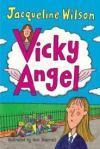 Vicky Angel was, by far, the most interesting of the books. It’s funny, because this is largely due to the truly-fictional element of the book (as well as the touch of romance). I mean, is Jade going bonkers, or is Jacqueline Wilson asserting ghosts are real? And that Vicky! Someone we love to hate.
Vicky Angel was, by far, the most interesting of the books. It’s funny, because this is largely due to the truly-fictional element of the book (as well as the touch of romance). I mean, is Jade going bonkers, or is Jacqueline Wilson asserting ghosts are real? And that Vicky! Someone we love to hate.
Girls in Tears. Fine, I’ll admit it. I have not finished this book yet. I’ll update the entry, later.



